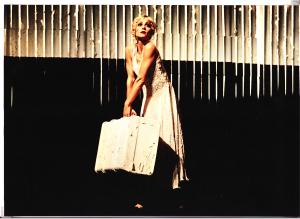A Streetcar Named Desire (2001)
Duration: 100’
Dance work in 5 acts for full orchestra, with additional pre-recorded track, commissioned by Northern Ballet Theatre
Choreographed by Didy Veldman
Dramaturg: Patricia Doyle
Designer: Es Devlin
Lighting Design: Ben Ormerod
Originally created on Charlotte Talbot and Jon Oliver
First performed at the Alhambra, Bradford in September 2001, by the Northern Ballet Theatre Orchestra, conducted by John Pryce-Jones.
It was Patricia Doyle who suggested to choreographer, Didy Veldman, that Tennessee Williams’ play, A Streetcar Named Desire would work well as a ballet. Veldman had been looking for a follow-up to her previous Northern Ballet Theatre work, Carmen, which had been a great success, and assembled a brilliant team to work with her including designer, Es Devlin, and the lighting designer Ben Ormerod.
Veldman was keen to use music that suggested the Streetcar era, although in reality the narrative of the ballet is not set in any specific era. However she wasn’t keen on jazz, which might have been the first musical port of call. So in the end we decided to use blues, as distinct from jazz, and put them at the very heart of the score. They are not only used between scenes as entr’actes, (which is how they would be used in a play), but they also feature as an essential part of the score, with existing blues songs being integrated completely into the texture of the music at several points. The harmonic language of the score is also significantly informed by the blues, being, in a very real sense, based on the major/minor duality that the blues encompass.
The music was not written chronologically, (ie. not from start to finish), but was constructed in a piecemeal fashion, jumping from scene to scene. That does not mean that a musical thread does not run through it – it is in fact quite the opposite; because a clear musical format had been established, it was possible to fill the score in bit by bit like a giant jigsaw puzzle.
It is probably the most complex electro-acoustic score that Philip Feeney has written for Northern Ballet Theatre. The task of integration of existing music, pre-recorded music and live music, via track and hardware sampler in the pit, the Akai S3000, was not easy, but gives the score an exciting living feeling. The keyboard player uses two synths, including the Roland JV5080 as well as the sampler. The synth is responsible for the high unearthly glass sound which comes to represent Blanche’s gradual unhinging from reality. High suspended notes are something of a common trait in Feeney’s music; in the Blue Ball pas de deux from Cinderella, for example, an actual wine glass is rung by a percussionist, and a high disembodied suspended sound is used to great effect at the end of the Fabulous Beast’s Giselle.
There are other extra-musical elements that help to make up the score. Sound effects that give a sense of urban dislocation, such as alarms and sirens, play an important part, and are started by a remote control in the pit. The duet with the young man is played against a background of electronic rain, and the sultry climate is evoked by an overdrive distortion effect that suggests the whirring of a fan. The music played by the onstage radio that interrupts the poker game and in the end gets thrown out of the window, actually emanates from a hidden onstage speaker, but the impression is that it comes from the radio itself.
Veldman’s depiction of the fair which Mitch and Blanche go to in Act 3 cleverly anthropomorphizes some of the attractions, in a Nutcracker sweeties kind of way, giving the composer a delicious opportunity for humouristic depiction of them in music; so, for example, we have a zinky vibraphone solo, played by John Melbourne, depicting candy floss, the fat low brass making great toffee apples, and the comedy electronic pitch bends representing scary ghosts!
The hard-hitting music for the poker scene in Act 2 takes the sampled words of gospel evangelist preacher, Rev Emmett Dickinson, and pastes them on to a forceful rhythmic backing, almost in the fashion of contemporary rap music. The original gospel recording is an attack against Christian hypocrisy entitled ‘Pig or Pup’ or ‘Two-faced Man’; the irreverent dancers heard it as a ‘Toothpaste Man!’
The music for A Streetcar Named Desire is recorded for CD by Northern Ballet Theatre Orchestra, conducted by John Pryce-Jones.
Charlotte Talbot as Blanche, photo courtesy of Northern Ballet.

